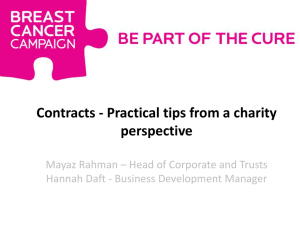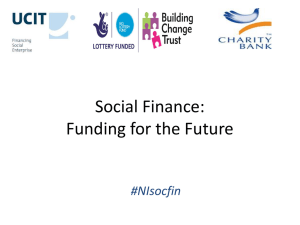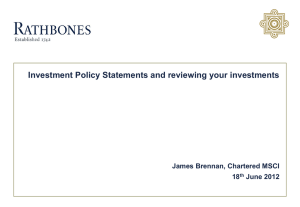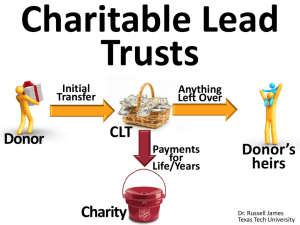Slides : (high res)
advertisement
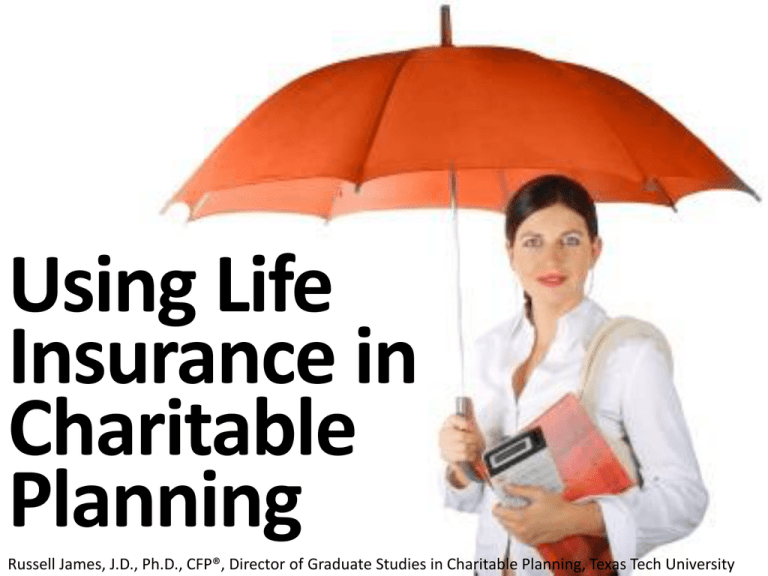
Using Life Insurance in Charitable Planning Russell James, J.D., Ph.D., CFP®, Director of Graduate Studies in Charitable Planning, Texas Tech University Common Uses 1.Wealth replacement 2.Gifting existing policies 3.Creating new policies for the charity Using Life Insurance as Wealth Replacement in Charitable Planning Charitable planning devices such as Charitable Gift Annuities, Gifts of Remainder Interests in Homes and Farms, and Charitable Remainder Trusts produce amazing tax advantages, reducing income taxes, capital gain taxes, and estate taxes But, they also reduce heirs’ inheritance Heir Charity Donor Life insurance can diminish this concern Estate tax law made simple 1. Anything you own is taxable at death unless it goes to a spouse or charity 2. If your life insurance is owned by another person or an Irrevocable Life Insurance Trust (ILIT) it is not taxable at your death (unless given in prior 3 years). Because the parent does not own the policy, it is not taxed in his estate Insurance Inc. Premium Payments Money to Pay Premiums Parent Estate Tax Free Death Benefit Policy on Parent’s Life Child Child Because the parent does not own the policy, it is not taxed in his estate Insurance Inc. Premium Payments Money to Pay Premiums Parent Estate Tax Free Death Benefit Policy on Parent’s Life Irrevocable Life Insurance Trust (ILIT) Child The parent can use the tax benefit or income from a CGA or CRT to pay for life insurance Insurance Inc. Premium Payments Money to Pay Premiums Parent Estate Tax Free Death Benefit Policy on Parent’s Life Irrevocable Life Insurance Trust (ILIT) Child Charitable Remainder Trust (CRT) Lifetime Income Money to Pay Premiums Parent Insurance Inc. Premium Payments Estate Tax Free Death Benefit Policy on Parent’s Life Irrevocable Life Insurance Trust (ILIT) Child The child gets a tax free inheritance instead of losing up to 55% in estate taxes Insurance Inc. Premium Payments Money to Pay Premiums Parent Estate Tax Free Death Benefit Policy on Parent’s Life Irrevocable Life Insurance Trust (ILIT) Child We give the taxable inheritance to charity, and create income to purchase the nontaxable inheritance to give to children Gifts for premiums can be gift tax free if ≤ $13,000 X beneficiaries X donors annually. (E.g., 2 parents to 2 children, spouses, and 4 grandchildren: 2 X 8 X $13,000 = $208,000 per year using “Crummey” powers) Money to Pay Premiums Parent Insurance Inc. Premium Payments Estate Tax Free Death Benefit Policy on Parent’s Life Irrevocable Life Insurance Trust (ILIT) Child Can it pay to be charitable? Priscilla wants to sell a $1,000,000 non-income producing zero-basis asset then spend the interest income of 5% while leaving principal for heirs. Her combined state and federal tax rates are: capital gains (20%) income (40%) estate (55%) Sale $1,000,000 asset -$200,000 capital gains tax CRUT $1,000,000 asset $0 capital gains tax $1,000,000 in 5% unitrust pays $50,000 annually + a charitable tax deduction of $300,000 worth $120,000 + ILIT Client pays $120,000 initially and $10,000 annually for a $400,000 ILIT-owned policy (including post-crummey gift taxes) Client uses $40,000/year ($800,000 X 5% return) Client uses $40,000/year Charity receives $1,000,000 remainder Heirs receive $360,000 ($800,000-$440,000 est. tax) Heirs receive $400,000 (tax free from ILIT) John, age 59, owns $100,000 of farmland which he would like to use for the rest of his life then leave to charity, but he also wants to benefit his heirs. His combined state and federal tax rates are income (40%) and estate (55%). Giving the remainder interest to charity creates a deduction of $65,553 worth $26,221. This will purchase a paid-up policy of about $50,000. [Using a 2% §7520 rate; the deduction falls as rates rise, but so does the price of the policy] John keeps lifetime use of farm Charity gets farm at death Heirs get $50,000 tax free Wealth replacement through ILIT life insurance creates estate tax free inheritance for family members and allows for charitable giving Part II Giving Existing Life Insurance Policies to Charity • Bought too much insurance for actual or current needs • Bought for children who are no longer dependent • Bought for an outdated business buy-sell agreement • Doesn’t need the cash value Valuing the gift of a life insurance policy Lesser of Fair Market Value (≈ Cash Value) or Donor’s Basis (≈ Net Premiums Paid) Newly issued policy: use first premium paid for fair market value Paid-up policy: use replacement policy for fair market value Changes in Valuation Approaches Old rule Basis is premiums paid – refunds – loans New addition Rev. Rul. 2009-13 reduces basis by “the cost of insurance protection that was enjoyed by the policyholder.” E.g., a term policy would have no basis except the unused part of the most recent premium For universal life policies, “Cost of Insurance” is reported to the policyholder. For traditional whole life policies, “Cost of Insurance” may not be reported or easily determined. For term insurance, “Cost of Insurance” is the premium. Changes in Valuation Approaches New addition Some policies can now be sold for more in the life settlement market Old rule FMV (≈ Cash Value) is “Interpolated Terminal Reserve” + Unused Part of Last Premium – Loans Note from charity before taxes filed or due (1) Date, location, and description of property (2) “No goods or services were provided in exchange for these gifts.” [or describe and value items provided] Summary of qualified appraisal attached to tax return Donor’s reliable recordsofgift,charity, date,place,FMV(and costbasisifrelevant) Neither the insurance agent who sold the policy nor the insurance company may prepare the appraisal because they are parties to the transaction Donating a policy with outstanding loans is bad planning! • In a normal bargain sale, the donation FMV is reduced by the loan amount. But, under new charitable split-dollar rules the deduction (for gift or future premiums) will be entirely lost. • Donor is taxed on ordinary income in the amount of loan less the applicable basis, which is loan amount X (policy basis/policy FMV) Don’t give life insurance with outstanding loans! After getting a policy the charity may • Ask donor to continue to pay premiums • Surrender it for cash value • Pay premiums from charity’s funds • Sell in the life settlement market Part III Creating new policies for the charity Option 1: Donor makes gifts to be used as premium payments Creation or Transfer of New Policy Insurance Inc. Death Benefit to Charity 2010 Gifts to be used for premiums Gifts are deductible if donor keeps no rights in the policy 2011 2012 2013 2014 … Death Option 2: Donor pays premiums on charityowned policy Creation or Transfer of New Policy Insurance Inc. Death Benefit to Charity 2010 Premium Payments Gifts are deductible if donor keeps no rights in the policy 2011 2012 2013 2014 … Death 1. Deductible so long as donor retains no rights in the policy Creation or Transfer of New Policy Insurance Inc. Death Benefit to Charity 2010 Gifts to be used for premiums 2011 2012 2013 2014 … Death 2. Deductible so long as donor retains no rights in the policy Creation or Transfer of New Policy Insurance Inc. Death Benefit to Charity 2010 Premium Payments 2011 2012 2013 2014 … Death 1. Standard gift receipt Insurance Inc. Creation or Transfer of New Policy Death Benefit to Charity 2010 Gifts to be used for premiums 2011 2012 2013 2014 … Death 2. Gift receipting practice depends on charity Creation or Transfer of New Policy Insurance Inc. Death Benefit to Charity 2010 Premium Payments 2011 2012 2013 2014 … Death 1. Donor can give appreciated property Creation or Transfer of New Policy Insurance Inc. Death Benefit to Charity 2010 Gifts to be used for premiums 2011 2012 2013 2014 … Death 2. Donor must give cash Insurance Inc. Creation or Transfer of New Policy Death Benefit to Charity 2010 Premium Payments 2011 2012 2013 2014 … Death 1. Income limitation of 50% for cash gifts Creation or Transfer of New Policy Insurance Inc. Death Benefit to Charity 2010 Gifts to be used for premiums 2011 2012 2013 2014 … Death 2. Income limitation of 30% “for the use of” charity Creation or Transfer of New Policy Insurance Inc. Death Benefit to Charity 2010 Premium Payments 2011 2012 2013 2014 … Death Potential Advantages and Problems for Charities and Donors Potential Advantages Donor with small income can fund a large posthumous project Potential Advantages Donor receives a bill from the life insurance company instead of ongoing donation requests from charity Potential Advantages Insurance agents may help to “sell” the idea instead of requiring charity fundraiser time Potential Problems Insurance agents may “oversell” risking longterm donor relationships Potential Problems Depending on policy structure, donor may give for years, and charity receives nothing due to later policy lapse Potential Problems Some policies may benefit insurance companies and agents more than charity Potential Problems Insurable Interest: Does the charity have sufficient financial interest in the donor’s life to allow it to take out a new policy of this size? (Absence may eliminate deductions and death benefit.) ??? Potential Problems The charity may prefer funds today Potential Problems The donor never sees the impact of his gift. Potential Problems Donors cannibalize giving to pay premiums Premium Payments Regular giving to charity A charity can prevent problems by refusing to accept policy gifts that don’t meet its guidelines. Assume cannibalization of gift income and require • Short-term (e.g., 10 year) to projected paid up status to age 100 • Top companies • Reasonable interest rate projections Otherwise, just say “No!” It isn’t “free” if the donors will be paying premiums instead of giving to your organization Common Uses 1.Wealth replacement 2.Gifting existing policies 3.Creating new policies for the charity Using Life Insurance in Charitable Planning Russell James, J.D., Ph.D., CFP®, Director of Graduate Studies in Charitable Planning, Texas Tech University Help me convince my bosses that continuing to build and post these slide sets is not a waste of time. If you work for a nonprofit or advise donors and you reviewed these slides, please let me know by clicking HERE If you clicked on the link to let me know you reviewed these slides… Thank You! For the audio lecture accompanying this slide set, go to EncourageGenerosity.com Think you understand it? Prove it! Click here to go to EncourageGenerosity.com and take the free quiz on this slide set. (Instantly graded with in depth explanations and a certificate of completion score report.) Graduate Studies in Charitable Financial Planning at Texas Tech University This slide set is from the introductory curriculum for the Graduate Certificate in Charitable Financial Planning at Texas Tech University, home to the nation’s largest graduate program in personal financial planning. To find out more about the online Graduate Certificate in Charitable Financial Planning go to www.EncourageGenerosity.com To find out more about the M.S. or Ph.D. in personal financial planning at Texas Tech University, go to www.depts.ttu.edu/pfp/ About the Author Me (about 5 years ago) ® Russell James, J.D., Ph.D., CFP is an Associate Professor and the Director of Graduate Studies in Charitable Planning in the Division of Personal Financial Planning at Texas Tech University. He graduated, cum laude, from the University of Missouri School of Law where he was a member of the Missouri Law Review. While in law school he received the Lecturing in Germany. 75 extra students United Missouri Bank Award for Most Outstanding Work in Gift and Estate Taxation showed up. I thought it was for me until I and Planning and the American Jurisprudence found out there was free beer afterwards. Award for Most Outstanding Work in Federal Income Taxation. After graduation, he worked At Giving Korea 2010. I as the Director of Planned Giving for Central didn’t notice until later Christian College, Moberly, Missouri for six the projector was years and also built a successful law practice shining on my head (inter-cultural height limited to estate and gift planning. He later problems). served as president of the college for more than five years, where he had direct and supervisory responsibility for all fundraising. Dr. James received his Ph.D. in Consumer & Family Economics from the University of Missouri where his dissertation was on the topic of charitable giving. Dr. James has over 100 publications in print or in press in academic journals, conference proceedings, professional periodicals, and books. He writes regularly for Advancing Philanthropy, the magazine of the Association of Fundraising Professionals. He has presented his research in the U.S. and across the world including as an invited speaker in Ireland, Scotland, England, The Netherlands, Spain, Germany, and South Korea. (click here for complete CV)

